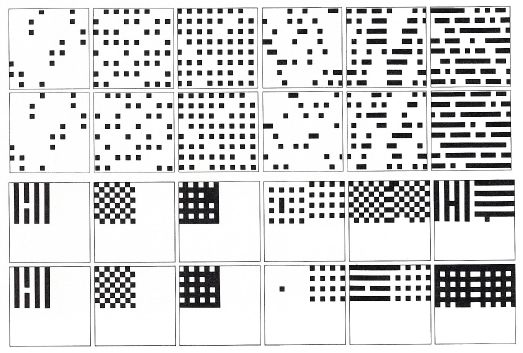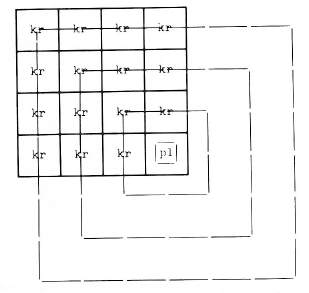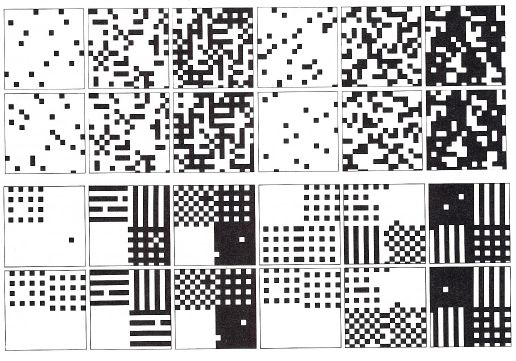PETER STRUYCKEN
SPLASH 1972/1974*
* This article is composed of extracts taken from publications documenting the artist's work.
In the course of the last few centuries, particularly in Europe, the plastic arts have found their development in a personal, strictly individual sphere. In the first place people sought and still seek to express their emotions therein. The element of inspiration, intuition, vision or whatever men wish to call it, was and is essential as indefinable. Art is felt to be something comparable to a living organism, the substance of which can be defined, but the essence of which escapes every analysis. Yet it is true and recently the realization has grown stronger, in spite of all theories, that a painting or sculpture speaks to us in the first place through visual means; visual means which are arranged by the artist in a specific interrelationship. The artist has worked this way and still does this more or less intuitively, so that in this arranging and handling of the material his personal temperament is revealed. Some artists, however, show an increasing tendency to banish the personal element from art in order to achieve an art which is determined by its own particular set of rules. Such an art would be placed above subjective preferences or concepts such as beautiful and ugly, because the work of art becomes the result of an indisputable, mathematical logic, which can only be qualified as true. However, such a work of art should not be labeled as inhuman, cerebral or sterile, since the longing for such an unassailable formula is very human; for was not this Plato's ideal of beauty?
I have searched for the elementary means of expression and I have formulated my findings in a set of propositions. It is my purpose to show that form and colour can be correlated mathematically; the result is not only a complete unity, but the interrelation of form and colour can be calculated as well. This might be of great importance when applied to town planning, architecture and industrial design. Thus, in town planning and architectural projects, the elements of which have a certain relationship as to size and form, it might be possible to apply colours which in their strength and tone acquire a corresponding relationship through which a complete unity of form and colour can be accomplished.

'Splash' is a program which allows the exploration of colour. The computer programme itself is just a number of logically formulated conditions. Their character is formalistic, they themselves having no content or meaning. When the computer programme is implemented, the conditions cause changes in the context of a previously established number of numerical values. These values are substituted by colour values when changes which they undergo during the course of the programme are made visible. A number, therefore, functions as a code for a particular colour. The number of colours corresponds to the number of numerical values. The result is a series of colour patterns which have undergone exactly the same changes as the numbers in the computer programme. For the sake of convenience the description of the conditions relevant for the programme always refers to 'colours' and 'colour patterns.' These terms can, if desired, be replaced by 'numbers' and 'number patterns.' The idea is to determine the quality of change, which can be big or small, sudden or gradual. The difference between the colour pattern is far more important than the colour patterns themselves; for it is this difference which indicates the kind and degree of change (which is the idea of this programme), the colour patterns simply appearing as 'pretty' or not 'pretty.'

In order to have a rough idea of the way in which the differences between the colour patterns are caused, we can make the comparison of a stone thrown into a pond. Concentric ripples emanate from the place where the stone hits the water, the 'splashdown.' The larger the ripples become, the weaker the wave. The effect of the splash on the water is thus strongest in the centre, decreasing towards the edge. This image of a splashdown with ripples of decreasing strength can be applied to a colour pattern. Here, the centre of the change is referred to as the 'splashdown,' the colours arranged concentrically around the splashdown representing the resulting (square) ripples. In the first example (see fig. 1), the area indicated by the black lines is the pattern of colours which undergo change. kr means kring (Dutch for ripple) and pl plons (Dutch for splash). The grey lines indicate the position of the ripples which are formed around the splashdown but which are outside the actually visible colour pattern. The colour change is naturally strongest at the splashdown. The colours on the ripples around the splashdown change to an ever-lessening extent. The colour change is weakest in the outmost ripple, the one which is furthest away from splashdown. This is as far as the comparison between a disturbed surface of water and a changed colour pattern goes.
The computer programme which changes colours in the manner just described provides a number of transitional states between a previously (arbitrarily) established colour pattern serving as initial state and another previously (arbitrarily) established colour pattern which is to be the final state, or 'target.' The changes occur in such a way that the initial colour pattern corresponds to an increasing degree with the final one. An important condition is that as large a number of colours as possible change at once at one step. When it is no longer possible for the colour pattern to change as a whole in one go, the programme permits part of the colour pattern to change. When this is no longer possible either, the last possibility is for one colour per state to change. These various phases of change, together with their effect on the colour programme, form the basis of the programme.
Amsterdam, Holland
August 1975


'SPLASH, 1972/1974'. The beginning of a splash sequence. Peter Struycken
Return to Table of Contents | Previous Section | Next Section

